Explore Luang Prabang - Laos Travel, Asia
Luang Prabang, nestled in northern Laos at the meeting point of the Mekong river and Nam Khan river, is a city celebrated for its rich cultural heritage and stunning natural beauty. Recognized as a UNESCO World Heritage Site in 1995, it boasts a unique blend of traditional Lao and French architecture that has been carefully preserved. Whether you're wandering through its ancient temples, admiring the local architecture, or soaking in the natural beauty of waterfalls and rivers, Luang Prabang offers something for everyone.
Population: Approximately 470,000 in 2020.
Economy: Luang Prabang's economy thrives on tourism, with its UNESCO status drawing visitors to its temples, natural wonders, and cultural experiences. Local crafts, hospitality, and small businesses also play vital roles, supporting the town's sustainable growth. Local crafts, hospitality, and small businesses also play vital roles, supporting the town's sustainable growth.
Landmarks: Famous for the Wat Xieng Thong, Royal Palace Museum (also known as Haw Kham), and Mount Phousi (Phou Si Hill).Luang Prabang, nestled in northern Laos at the meeting point of the Mekong river and Nam Khan river, is a city celebrated for its rich cultural heritage and stunning natural beauty. Recognized as a UNESCO World Heritage Site in 1995, it boasts a unique blend of traditional Lao and French architecture that has been carefully preserved. Whether you're wandering through its ancient temples, admiring the local architecture, or soaking in the natural beauty of waterfalls and rivers, Luang Prabang offers something for everyone.
Population: Approximately 470,000 in 2020.
Economy: Luang Prabang's economy thrives on tourism, with its UNESCO status drawing visitors to its temples, natural wonders, and cultural experiences. Local crafts, hospitality, and small businesses also play vital roles, supporting the town's sustainable growth. Local crafts, hospitality, and small businesses also play vital roles, supporting the town's sustainable growth.
Landmarks: Famous for the Wat Xieng Thong, Royal Palace Museum (also known as Haw Kham), and Mount Phousi (Phou Si Hill).
Laos
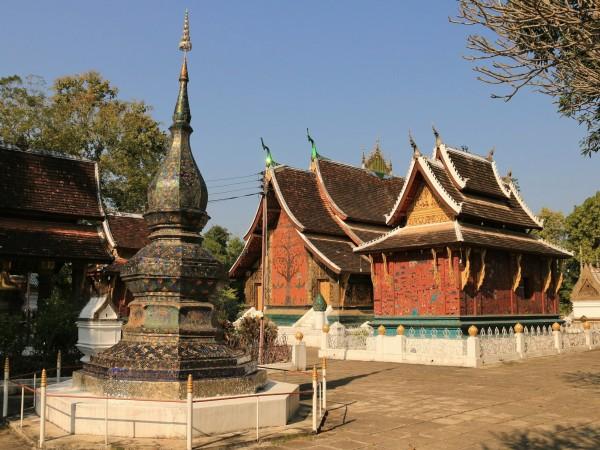
Overview of Luang Prabang
History & Cultural Influence
Luang Prabang's rich history and cultural influence have made it one of Southeast Asia’s most captivating cities. Archaeological evidence traces its origins back to 8,000 BC, establishing it as a city with deep cultural roots. Over time, Luang Prabang developed into a hub for Buddhist learning and artistic expression with the arrival of the sacred golden Buddha, Phra Bang, in 1512, which gave the city its current name. The French colonial period in the late 19th century introduced European architectural elements, blending beautifully with traditional Lao structures, a fusion that still defines the city today. Declared a UNESCO World Heritage Site in 1995, Luang Prabang’s well-preserved mix of cultural influences continues to charm visitors.
Interaction with The Locals
Luang Prabang is home to a population mixed primarily of Lao ethnicity. The town's citizens maintain strong cultural ties, with Buddhism playing a central role in daily life. You'll often see monks in saffron robes, highlighting the deep spiritual connection of the community. Despite the growing tourism, the people of Luang Prabang have preserved their traditional ways, blending them seamlessly with modern influences. This balance gives the town its unique charm and cultural authenticity.
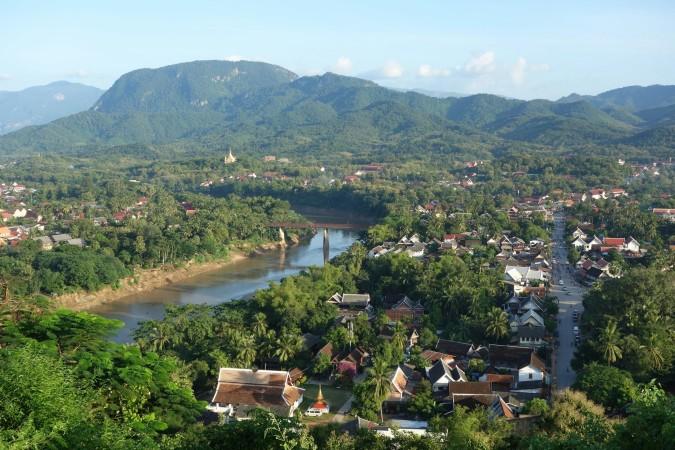
Luang Prabang, Laos - © CJ Botha
Top Attractions in Luang Prabang
Kuang Si Falls
Kuang Si Falls is a stunning natural wonder that you won't want to miss. This three-tier waterfall, surrounded by lush jungle, offers refreshing turquoise pools where you can take a dip to cool off. If you're feeling adventurous, a hike to the top rewards you with incredible panoramic views. Plus, nearby is a bear sanctuary where you can learn about efforts to protect rescued Asiatic black bears, adding a meaningful touch to your visit.
Wat Xieng Thong
Wat Xieng Thong is one of the most visually striking temples in all of Laos. Built in 1560, its sweeping roof and intricate mosaics make it an architectural masterpiece. This temple is a perfect reflection of the city's deep spiritual and cultural heritage, and wandering its grounds feels like stepping back in time. If you’re interested in history and culture, this is an essential stop.
Mount Phousi
For unbeatable views of Luang Prabang, a climb up Mount Phousi is a must. The 328 steps might sound daunting, but the reward is worth it—panoramic views over the city, the Mekong, and Nam Khan rivers. At the summit, you'll find Wat Chom Si, a peaceful temple that's a favorite spot for watching the sunset and painting the sky in stunning colors. It’s a perfect blend of physical activity and serene beauty.
Royal Palace Museum (Haw Kham)
The Royal Palace Museum is a window into the royal history of Laos. Once the residence of the royal family, the building itself is a beautiful mix of French colonial and traditional Lao architecture. Inside, you’ll discover artifacts and personal belongings that offer a fascinating glimpse into the royal lifestyle. It’s an insightful stop for anyone interested in the history and culture of this charming city.
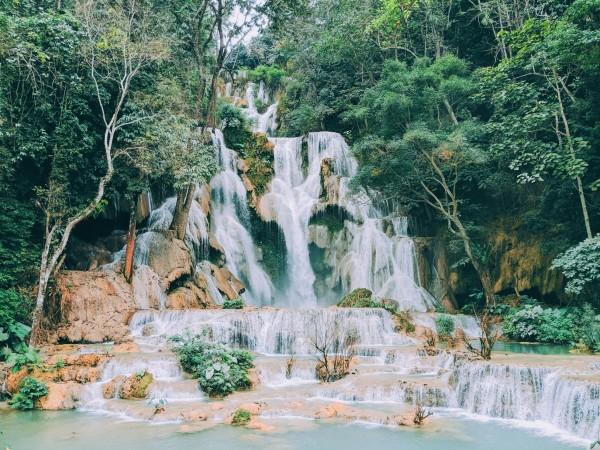
Kuang Si Falls - © note thanun
Must-Try Dishes in Luang Prabang
- Or Lam: Or Lam is a hearty, flavorful stew that truly represents the rustic cuisine of Luang Prabang. Made with tender buffalo meat, vegetables, and a unique local herb called "sakhan," this dish is a must-try for anyone looking to experience authentic Lao flavors.
- Jaew Bong: Known as the "soul" of Lao cuisine, Jaew Bong is a spicy, smoky chili paste made from dried chilies, garlic, shallots, and often buffalo skin. It’s a staple condiment in Luang Prabang and pairs beautifully with sticky rice or grilled meats.
- Khai Pen: Khai Pen is a unique local snack made from dried river weed harvested from the Mekong River. Lightly fried with sesame seeds and garlic, it offers a crispy texture and subtle flavors that highlight the significance of the Mekong in Luang Prabang’s culinary traditions.
- Sai Oua: Sai Oua is a fragrant pork sausage packed with local herbs like lemongrass, ginger, and kaffir lime leaves. Grilled to perfection, this street food favorite is bursting with flavor and showcases the region’s skill in blending aromatic ingredients.
- Khao Soi: Luang Prabang’s version of Khao Soi is a noodle soup dish that’s a bit different from the Thai version. This comforting bowl features wide rice noodles in a rich, tomato-based broth, topped with minced pork, fermented soybeans, and a drizzle of chili oil.
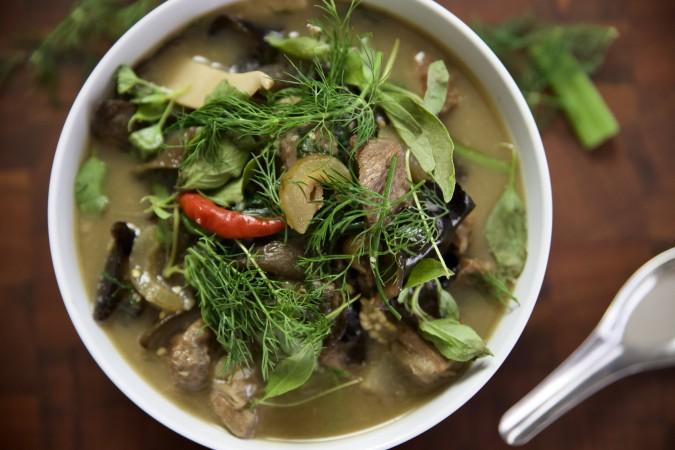
Or Lam - © Saeng's Kitchen
Festivals & Local Celebrations
Pi Mai Lao (Lao New Year)
Pi Mai Lao is the biggest and most important festival in Luang Prabang, and visitors are in for an unforgettable experience. Expect lively water-splashing festivities across the city, a grand parade with locals dressed in beautiful traditional costumes, and even an elephant procession through the streets. The celebration also includes a beauty pageant to crown "Miss Lao New Year," sand stupa building along the Mekong River, and a sacred ceremony at Wat Mai where the Prabang Buddha statue is displayed for a special watering ritual.
Boun Lai Heua Fai (Festival of Light)
Marking the end of Buddhist Lent, Boun Lai Heua Fai is a magical festival that lights up the Mekong River with thousands of handmade boats illuminated by candles. Visitors can witness colorful boat processions, homes and temples adorned with glowing lanterns, and a lively atmosphere as locals pay homage to the water spirits, hoping for good fortune in the coming year.
Hmong New Year
Celebrating the unique culture of the Hmong ethnic minority, Hmong New Year is a vibrant festival filled with tradition. Visitors will see Hmong people dressed in their finest traditional attire, enjoy musical performances, and experience cultural ceremonies. One highlight is the traditional game "pov pob," or ball tossing, which is a key part of the celebration, offering an authentic glimpse into Hmong customs and community spirit.
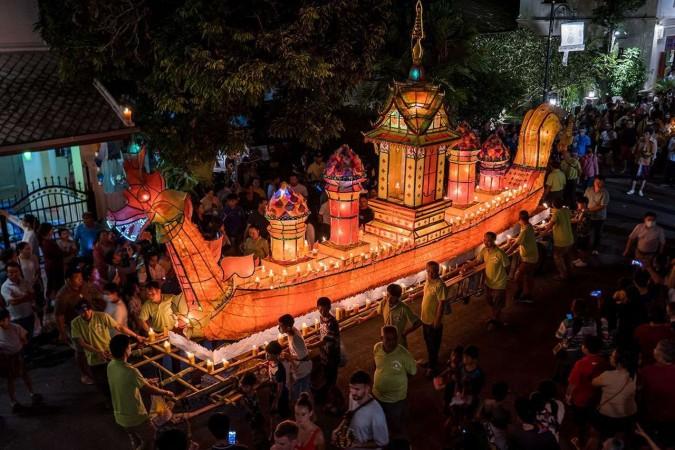
Boun Lai Heua Fai (Festival of Light) - © Ock Pop Tok
What to Do in Luang Prabang
- Outdoor Adventures: For nature enthusiasts, Kuang Si Waterfall is a must-visit destination. You can swim in its turquoise pools, hike through lush trails, and explore the nearby bear sanctuary. Additionally, a Mekong River cruise offers a serene way to soak in the stunning landscapes and observe local fishing practices.
- Cultural Experiences: Immerse yourself in the rich heritage of Luang Prabang by participating in a traditional Buddhist almsgiving ceremony (Tak Bat) at dawn. This serene experience allows visitors to witness the daily lives of monks and engage in meaningful cultural practices.
- Temple Tours: The town is dotted with beautiful temples. A guided tour can take you to iconic sites like Wat Xieng Thong and Wat Phu Si, where you can admire intricate architecture and learn about the spiritual significance of these places.
Shopping in Luang Prabang
- Night Market: Located in the heart of Luang Prabang, the Night Market is a must-visit for travelers seeking handmade crafts, textiles, and traditional clothing. Open every evening from 17:00 to 22:00, this lively market offers a wide variety of local goods, making it a perfect spot to pick up unique souvenirs.
- Ban Xang Khong: This traditional neighborhood is famous for its papermaking and textile work. Visitors can discover beautiful handmade paper products, lanterns, and high-quality silk and cotton fabrics here, making it a unique shopping destination.
- Ock Pop Tok Store: Centrally located in Luang Prabang, Ock Pop Tok is known for its high-quality silk, hemp, and cotton textiles. They offer a mix of contemporary and traditional designs, providing a diverse range of beautiful fabrics.
- Ban Phan Luang: Known for its expertise in silver and bronze work, Ban Phan Luang is a hub for traditional jewelry and decorative items. Visitors can find beautifully crafted pieces that reflect the local artistry.
- Khinthong Lao Silk: Specializing in handwoven textiles by Tai Daeng women, Khinthong Lao Silk is known for intricate patterns and beautiful fabrics, making it a great stop for anyone interested in traditional Lao weaving.
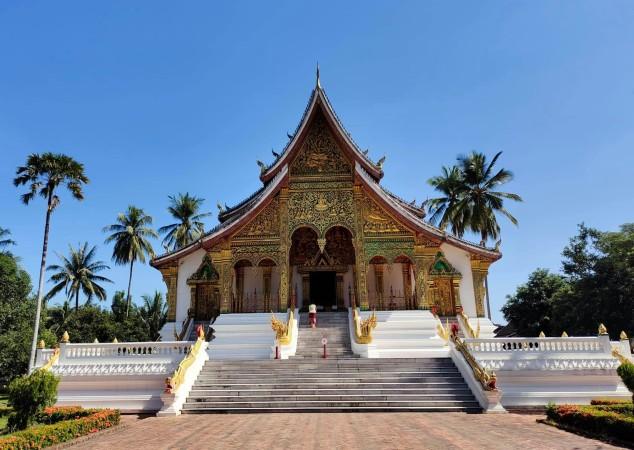
Wat Xieng Thong - © Life on the road
Weather in Luang Prabang: Best Time to Visit
The city experiences a tropical monsoon climate with distinct seasons: dry, wet, and cool. Understanding the weather pattern in Luang Prabang will help you make the most of your visit to this wonderful land.
Dry Season in Luang Prabang
The dry season is the most popular time to visit Luang Prabang. Temperatures range from 15°C (59°F) at night to around 30°C (86°F) during the day. The weather is generally sunny and pleasant, making it ideal for exploring the town's attractions and outdoor activities. Visitors can enjoy the vibrant atmosphere of local festivals, such as the Lao New Year in April.
Wet Season in Luang Prabang
The wet season in Luang Prabang is characterized by high humidity and frequent rainfall. From April to October, temperatures typically hover between 23°C (73°F) and 33°C (91°F). While the rain can be heavy at times, it often comes in short bursts, allowing for sunny spells. This season brings lush greenery to the landscape, making it a beautiful time for nature lovers to visit, particularly the stunning Kuang Si Waterfall.
Cool Season in Luang Prabang
During the cool season, temperatures can drop to around 10°C (50°F) at night, while daytime temperatures range from 20°C (68°F) to 25°C (77°F). This season is ideal for those who prefer milder weather and fewer crowds. It's a wonderful time to experience local culture, including temple visits and traditional ceremonies, as the cool temperatures make exploring comfortable.
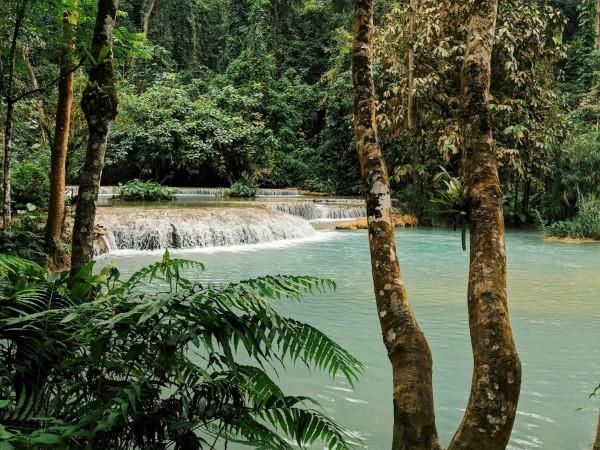
Experience Luang Prabang's untouched nature - © note thanun
Essential Travel Information
Getting Around Luang Prabang
- Public Transit: There is no regular public bus system within Luang Prabang, but taxis and tuk-tuks are common. Tuk-tuks are the main form of public transportation, though it’s best to negotiate the fare before your ride.
- Taxis and Tuk-tuks: Taxis can be hired but are not as widespread as tuk-tuks, which are a more popular option for getting around. Remember to settle on a price with tuk-tuk drivers before starting your journey.
- Motorbikes: Motorbikes are a popular choice for tourists wanting to explore more freely and are available for rent in the city.
- Walking: The city center is compact and easy to explore on foot. With four main roads running along the peninsula where the Nam Khan and Mekong Rivers meet, walking is often the most pleasant way to experience the local sights.
- Boat: For a unique experience, slow boat services on the Mekong River take travelers from Huay Xai to Luang Prabang, a journey that spans two relaxing days.
ATM and Banking Services
- ATM Availability: Luang Prabang is well-equipped with over 1,300 ATMs across Laos, many of which are conveniently located in key areas such as airports, market squares, and popular tourist spots.
- Card Acceptance: Most ATMs in Luang Prabang accept Visa, Mastercard, Cirrus, Plus, JCB, and American Express. However, cards like Diners, Discover, and RuPay may have limited acceptance, so it’s best to check beforehand.
Where to Stay in Luang Prabang
- Luxury Resorts: If you're looking for a more indulgent experience, luxury resorts in Luang Prabang offer stunning views and exceptional amenities. Many of these resorts are situated along the Mekong River or nestled in lush gardens, providing a peaceful retreat. Guests can enjoy spa services, fine dining, and guided excursions to explore the area's natural beauty.
- Boutique Hotels: Luang Prabang is also home to several boutique hotels that combine comfort with local charm. These establishments often feature traditional Laotian architecture and decor, creating a unique ambiance. Many boutique hotels also offer personalized services, including guided tours and cooking classes, ensuring a memorable stay.
- Guesthouses & Homestays: For budget travelers, numerous guesthouses and homestays provide affordable yet cozy accommodations. These family-run establishments are a great way to experience local hospitality.
Des articles pour vous

Explore Anuradhapura - Sri Lanka Travel, Asia
Anuradhapura is not just a place to visit, it’s a place to feel. Nestled in Sri Lanka’s North Central Province, this UNESCO World Heritage Site invites travelers to walk among sacred stupas, ancient ruins, and vibrant rituals that span over two millennia. Known as one of the world’s oldest continuously inhabited cities, Anuradhapura blends religious reverence, royal history, and everyday village life. Whether you’re a spiritual seeker, a history lover, or a curious wanderer, this ancient city offers a deep and memorable journey into the heart of Sri Lanka’s cultural identity.
Population: Approximately 950,000 in 2022.
Economy: Anuradhapura’s economy is primarily driven by agriculture, religious tourism, and small-scale trade. The region is known for rice farming, supported by ancient irrigation systems. Tourism, linked to its UNESCO World Heritage status, also plays a vital role, in supporting local businesses, guides, and hospitality services.
Landmarks: Famous for the Sri Maha Bodhi Tree, Ruwanwelisaya Stupa, and Jetavanaramaya Monastery.

Explore Polonnaruwa - Sri Lanka Travel, Asia
Polonnaruwa isn’t just a place but a journey back in time. Tucked in the heart of Sri Lanka’s Cultural Triangle, this UNESCO World Heritage Site is a wonderland of ancient ruins, sacred temples, and royal architecture that whisper tales of a grand past. Once a thriving capital of Sinhalese kings and a center of Buddhist learning, Polonnaruwa today blends history, serenity, and cultural charm. Explore majestic stone carvings, cycle through peaceful landscapes, and connect with locals who embody Sri Lanka’s warm spirit. With every step, you'll uncover layers of a story that spans centuries.
Population: Approximately 450,000 in 2022.
Economy: Polonnaruwa’s economy is primarily driven by agriculture, especially rice cultivation, supported by ancient irrigation systems like Parakrama Samudra. Tourism also plays a key role, with small-scale trading, handicrafts, and local services contributing to the town’s economic fabric.
Landmarks: Famous for the Gal Vihara, Parakrama Samudra, and The Royal Palace of King Parakramabahu I.

Explore Dambulla - Sri Lanka Travel, Asia
Tucked away in Sri Lanka’s Central Province, Dambulla is more than a stopover—it’s a window into the island’s spiritual soul. This town is best known for the Dambulla Cave Temple, a UNESCO World Heritage Site that guards over two millennia of Buddhist art and devotion. But beyond its famed rock shrines lies a land of rolling hills, vibrant markets, and friendly locals. Just a short drive from Sigiriya Rock Fortress and the Cultural Triangle, it’s the perfect base to explore the heart of Sri Lanka.
Population: Approximately 72,000 in 2022.
Economy: Dambulla’s economy thrives on agriculture, tourism, and trade as a major hub in Sri Lanka’s vegetable and fruit supply chain. Tourism also plays a key role in local crafts, hospitality, and transport services, further supporting the regional economy.
Landmarks: Famous for the Dambulla Cave Temple, Sigiriya Rock Fortress, and The Dambulla Dedicated Economic Centre.

Voyage à Kampong Cham - Cambodge, Asie
Kampong Cham est une charmante ville riveraine située le long du fleuve Mékong. Connue pour son importance historique et ses attractions culturelles, Kampong Cham offre un mélange d'architecture coloniale, de temples anciens et de paysages pittoresques. Kampong Cham est reliée au district voisin de Tbong Khmum par le pont Kizuna, le premier pont au Cambodge à traverser le fleuve Mékong, en faisant un carrefour de transport crucial pour la région.
Population : Estimation de 80 000 habitants (en 2024)
Économie : Bien que n'étant pas encore une destination touristique majeure, Kampong Cham propose des sites culturels et historiques, tels que le temple Wat Nokor et le pont en bambou de Koh Pen, ainsi que des attractions naturelles comme des forêts et des chutes d'eau. Le gouvernement se concentre sur le développement du tourisme pour améliorer l'économie locale.
Points d'intérêt : Wat Nokor Bachey, Phnom Han Chey, Phnom Pros et Phnom Srey, pont en bambou de Koh Pen, Wat Joy T'maw, Preah Theat Teuk Chha, piste d'atterrissage abandonnée de l'US.

Explorez Nha Trang - Voyage au centre du Vietnam, Asie
Nichée le long de la magnifique côte du Vietnam, Nha Trang se distingue comme une destination de premier choix pour les voyageurs. Cette ville côtière, réputée pour ses superbes plages et sa vie marine foisonnante, s'adresse à tous. Nha Trang vous accueille à bras ouverts, que vous recherchiez des aventures, de la culture ou de la détente au bord de la mer. Ce guide vous fera découvrir les points forts de cet endroit magnifique, facilitant ainsi la planification de votre voyage de manière fluide et excitante.
Population : Environ 423 000 habitants en 2019.
Économie : L'un des principaux centres touristiques du Vietnam et la plus grande économie de la province de Khanh Hoa.
Sites emblématiques : Célèbre pour les tours Cham de Po Nagar, la cathédrale de Nha Trang et l'île Hon Mun.

Voyage à Sihanoukville - Cambodge, Asie
Sihanoukville, une ville côtière du sud-ouest du Cambodge, est la capitale de la province de Preah Sihanouk. Située sur une péninsule le long du golfe de Thaïlande, la ville est bien reliée à Phnom Penh par des autoroutes principales et dispose d'un aéroport international.
La ville abrite le seul port en eau profonde du Cambodge, jouant un rôle crucial dans la logistique et le commerce du pays. Les plages magnifiques de Sihanoukville, telles qu'Ochheuteal et Serendipity, attirent aussi bien les touristes nationaux qu'internationaux. Le développement économique a prospéré ces dernières années, en particulier grâce à la création de la Zone économique spéciale de Sihanoukville (SSEZ) et aux investissements chinois dans les casinos, l'immobilier et les stations balnéaires. La ville offre également des attractions naturelles telles que le parc national de Ream et plusieurs îles voisines, en faisant une destination variée pour les voyageurs d'affaires et de loisirs.
Population : La population de Sihanoukville était d'environ 160 000 habitants en 2024.
Économie : Sihanoukville, une ville côtière en pleine croissance au Cambodge, se distingue par son mélange dynamique de développement économique et de tourisme. La Zone économique spéciale de Sihanoukville (SSEZ) est devenue un pôle industriel majeur, abritant plus de 180 entreprises et créant des milliers d'emplois. Avec le seul port en eau profonde du Cambodge, la ville joue un rôle clé dans le commerce et la logistique du pays. Bien qu'elle se soit transformée d'une petite ville balnéaire tranquille en un centre urbain animé, Sihanoukville reste célèbre pour ses plages immaculées, attirant des touristes tout au long de l'année. Les investissements chinois importants ont alimenté la croissance des hôtels, des casinos et de l'immobilier, faisant de la ville un centre d'opportunités économiques et d'hospitalité.
Monuments : Plage d'Otres, Plage d'Ochheuteal, Plage de l'Indépendance, Parc national de Ream, Chute d'eau de Kbal Chhay, Monument des Lions d'Or, Wat Leu.
